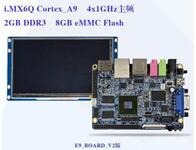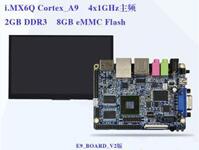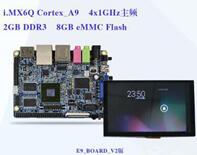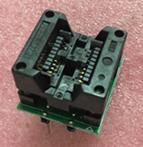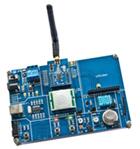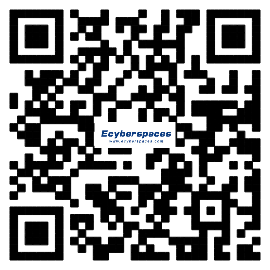Processor Parameters
•Core: ARM 32-bit Cortex™-M4 CPU with FPU, Adaptive real-time accelerator (ART Accelerator™) allowing 0
-wait state execution from Flash memory, frequency up to 168 MHz, memory protection unit, 210 DMIPS/1.25
DMIPS/MHz (Dhrystone 2.1), and DSP instructions
•Memories
•Up to 1 Mbyte of Flash memory
•Up to 192+4 Kbytes of SRAM including 64-Kbyte of CCM (core coupled memory) data RAM
•Flexible static memory controller supporting Compact Flash, SRAM, PSRAM, NOR and NAND memories
•LCD parallel interface, 8080/6800 modes
•Clock, reset and supply management
•1.8 V to 3.6 V application supply and I/Os
•POR, PDR, PVD and BOR
•4-to-26 MHz crystal oscillator
•Internal 16 MHz factory-trimmed RC (1% accuracy)
•32 kHz oscillator for RTC with calibration
•Internal 32 kHz RC with calibration
•Sleep, Stop and Standby modes
•VBATsupply for RTC, 20×32 bit backup registers + optional 4 KB backup SRAM
•3×12-bit, 2.4 MSPS A/D converters: up to 24 channels and 7.2 MSPS in triple interleaved mode
•2×12-bit D/A converters
•General-purpose DMA: 16-stream DMA controller with FIFOs and burst support
•Up to 17 timers: up to twelve 16-bit and two 32-bit timers up to 168 MHz, each with up to 4 IC/OC/PWM or pulse counter and quadrature (incremental) encoder input
•Debug mode
•Serial wire debug (SWD) & JTAG interfaces
•Cortex-M4 Embedded Trace Macrocell™
•Up to 140 I/O ports with interrupt capability
•Up to 136 fast I/Os up to 84 MHz
•Up to 138 5 V-tolerant I/Os
•Up to 15 communication interfaces
•Up to 3 × I2C interfaces (SMBus/PMBus)
•Up to 4 USARTs/2 UARTs (10.5 Mbit/s, ISO 7816 interface, LIN, IrDA, modem control)
•Up to 3 SPIs (37.5 Mbits/s), 2 with muxed full-duplex I2S to achieve audio class accuracy via internal audio PLL or external clock
•2 × CAN interfaces (2.0B Active)
•SDIO interface
•Advanced connectivity•USB 2.0 full-speed device/host/OTG controller with on-chip PHY
•USB 2.0 high-speed/full-speed device/host/OTG controller with dedicated DMA, on-chip full-speed PHY and ULPI
•10/100 Ethernet MAC with dedicated DMA: supports IEEE 1588v2 hardware, MII/RMII
•8- to 14-bit parallel camera interface up to 54 Mbytes/s
•True random number generator
•CRC calculation unit
•96-bit unique ID
•RTC: subsecond accuracy, hardware calendar
Development board hardware configuration
1) 16M Bit high speed asynchronous CMOS static RAM
2) 4G Bit NAND Flash
3) IIC EEPROM
Function description
1 With the HTTP Webpage server function, can the image through Webpage way to view camera, network camera functions
2 Full speed USB interface can read U disk, high speed USB interface connected to host computer and 3.2 inch touch screen together to achieve the function of touchpad
3 Audio can play stored in SD card WAV format audio files, (plus a recording module) can be recorded voice file to SD card
4 Images can be collected by camera compressed to save JPEG or BMP format file to SD card
5 browse the image file stored in the SD card
Example Program Characteristics
1 Operating system
RTX--V4.20 (Keil operating system)
FreeRTOS--V7.1.1
C/OS-II--V2.86
RT-Thread - V1.1.0
2 File system
RL-FlashFS--V4.22 (Keil file system, support FAT12, FAT16 and FAT32 file system, the file system can be used in the SD card, Nand Flash, U disk, provide bad block management function of Nand Flash)
FatFs--R0.08a
3 Network protocol stack
RL-TCPnet--V4.23 (Keil network protocol stack)
Lwip--V1.3.2
4 Graphics Library
The new version of C/GUI emWin--V5.12
STM32 Embedded GUI Library--V2.1.0; ST release of the embedded GUI graphics library
C/GUI—emWin (old version) with source code
5 JPEG codec: Libjpeg--v8d
6 USB
RL-USB--V4.22; Keil comes with the USB protocol stack, support ADC, CDC, HID, MSC class from the equipment, the main controller supporting HID and MSC
USB-Host-Device Lib-- V2.1.0; ST USB protocol stack, support ADC, CDC, HID, MSC, DFU class from the equipment, the main controller supporting HID and MSC
Shipping list
1* STM32F407IGT6 Core Board








 Development Kit
Development Kit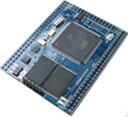
 Mouse over to zoom in
Mouse over to zoom in


